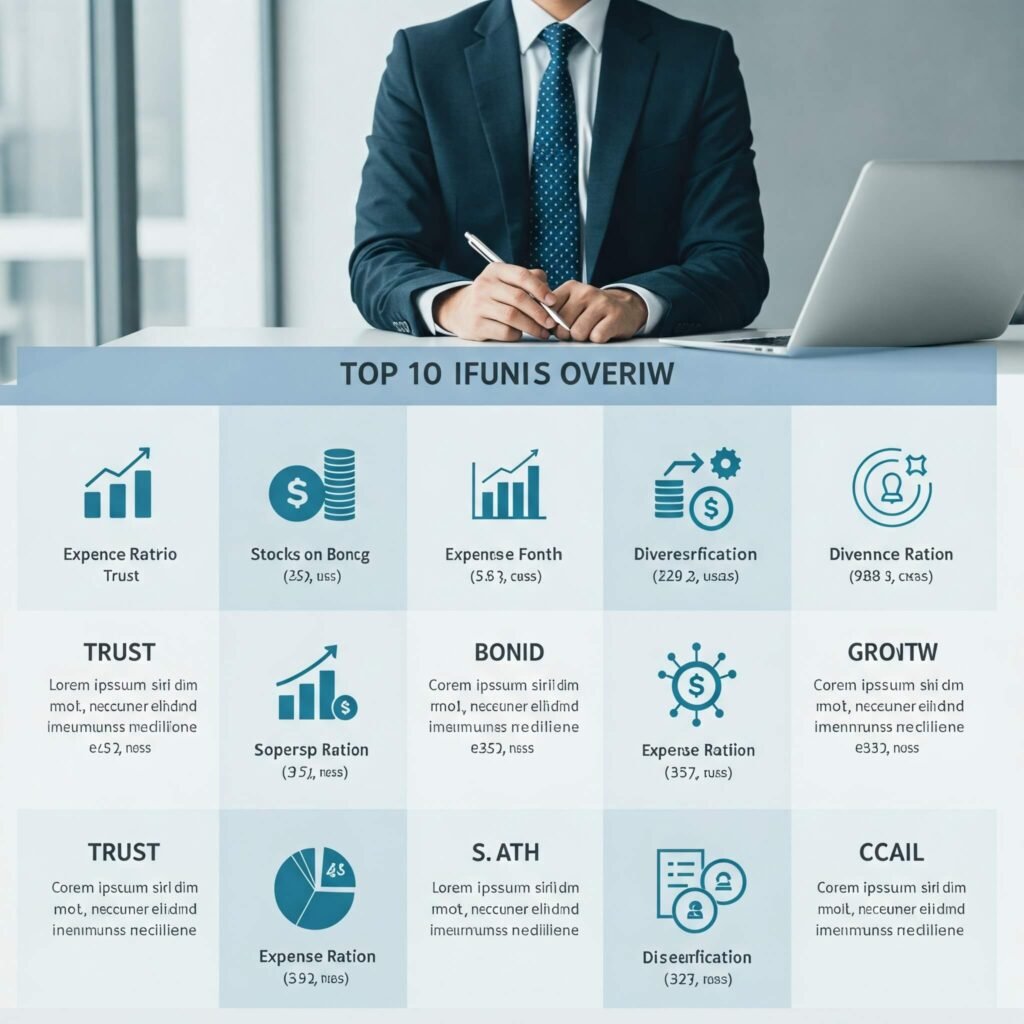
Why Index Funds Are Ideal for Building Wealth in 2025
Index funds track market indices like the S&P 500, providing broad exposure to stocks or bonds at minimal cost. A 2024 Morningstar study found that 87% of actively managed funds underperformed their benchmarks over 10 years, while index funds consistently matched market returns. With low expense ratios and diversification, they’re perfect for long-term wealth creation.
Benefits of Index Funds
- Low Costs: Expense ratios as low as 0.03% save you money over time.
- Diversification: Exposure to hundreds or thousands of securities reduces risk.
- Simplicity: Passive management means less time monitoring your portfolio.
For example, Sarah, a 30-year-old teacher, invested $200/month in an S&P 500 index fund. After 10 years, her portfolio grew to $38,000, thanks to steady market growth.
Outbound Link: Learn more about index fund benefits at NerdWallet.
Criteria for Selecting the Best Index Funds for 2025
To choose the top 10 index funds for building wealth, we evaluated:
- Expense Ratio: Lower fees maximize returns.
- Tracking Error: How closely the fund mirrors its index.
- Assets Under Management (AUM): Larger funds offer liquidity.
- Performance History: Consistent returns over 3-5 years.
- Diversification: Broad exposure across sectors or asset classes.
Top 10 Best Index Funds for Building Wealth in 2025
Here are the top 10 index funds for 2025, ideal for building wealth over the long term.
1. Vanguard Total Stock Market Index Fund (VTI)
- Index Tracked: CRSP US Total Market
- Expense Ratio: 0.03%
- Why It’s Great: Tracks over 3,600 U.S. stocks, offering unmatched diversification.
- Performance: ~10% average annual return over 10 years.
Example: John, a 35-year-old engineer, invests $5,000 in VTI. With a 10% return, it could grow to $12,970 in 10 years.
Outbound Link: Explore VTI at Vanguard.
2. Fidelity ZERO Large Cap Index Fund (FNILX)
- Index Tracked: Fidelity U.S. Large Cap Index
- Expense Ratio: 0.00%
- Why It’s Great: No fees and tracks 500+ large-cap U.S. stocks, similar to the S&P 500.
- Performance: ~17% average annual return over 5 years (as of early 2025).
3. Schwab U.S. Small-Cap ETF (SCHA)
- Index Tracked: Dow Jones U.S. Small-Cap Total Stock Market
- Expense Ratio: 0.04%
- Why It’s Great: Captures 1,757 small-cap stocks for growth potential.
- Performance: ~12% average annual return over 5 years.
4. Vanguard S&P 500 ETF (VOO)
- Index Tracked: S&P 500
- Expense Ratio: 0.03%
- Why It’s Great: Tracks 500 leading U.S. companies with a proven track record.
- Performance: ~10% average annual return over decades.
5. iShares Core MSCI Emerging Markets ETF (IEMG)
- Index Tracked: MSCI Emerging Markets Investable Market
- Expense Ratio: 0.08%
- Why It’s Great: Diversifies with 2,900+ emerging market stocks.
- Performance: ~8% average annual return over 5 years.
6. Vanguard Total Bond Market ETF (BND)
- Index Tracked: Bloomberg U.S. Aggregate Float Adjusted
- Expense Ratio: 0.03%
- Why It’s Great: Holds 11,000+ bonds for stability and income.
- Performance: ~4% average annual return over 5 years.
7. Vanguard Growth ETF (VUG)
- Index Tracked: CRSP US Large Cap Growth
- Expense Ratio: 0.04%
- Why It’s Great: Focuses on 180 growth-oriented large-cap stocks.
- Performance: ~19% average annual return over 5 years.

8. Vanguard Real Estate ETF (VNQ)
- Index Tracked: MSCI US Investable Market Real Estate 25/50
- Expense Ratio: 0.12%
- Why It’s Great: Offers real estate exposure with attractive yields.
- Performance: ~7% average annual return over 5 years.
9. Invesco QQQ Trust (QQQ)
- Index Tracked: Nasdaq-100
- Expense Ratio: 0.20%
- Why It’s Great: Tracks 100 tech-heavy, non-financial companies.
- Performance: ~20% average annual return over 5 years.
10. Fidelity U.S. Bond Index Fund (FXNAX)
- Index Tracked: Bloomberg U.S. Aggregate Bond
- Expense Ratio: 0.025%
- Why It’s Great: Low-cost bond fund for conservative investors.
- Performance: ~3.5% average annual return over 5 years.
Outbound Link: Compare index funds at Morningstar.
How to Choose the Best Index Fund for Your Wealth-Building Goals
Selecting the right index fund depends on your goals and risk tolerance:
- Long-Term Growth: Choose VTI or VOO for broad U.S. market exposure.
- Higher Risk, Higher Reward: Opt for SCHA or VUG for small-cap or growth stocks.
- Stability: BND or FXNAX offer bond market exposure.
- Diversification: IEMG adds emerging markets to your portfolio.
Pro Tip: Start with a core holding like VTI, then add specialized funds like VNQ or IEMG for diversification.

Tips for Building Wealth with Index Funds in 2025
Maximize your returns with these strategies:
- Invest Regularly: Use dollar-cost averaging with a Systematic Investment Plan (SIP).
- Keep Fees Low: Stick to funds with expense ratios below 0.2%.
- Stay Long-Term: Hold for 5-10+ years to ride out market volatility.
- Rebalance Annually: Adjust allocations to maintain your desired risk level.
For instance, Lisa, a 28-year-old freelancer, started a $100/month SIP in VOO. After five years, her investment grew to $7,800 despite market dips.
Outbound Link: Get investing tips at The Motley Fool.
Key Takeaways for Building Wealth with Index Funds
- Start with Broad Funds: VTI or VOO provide solid foundations.
- Diversify Smartly: Add IEMG, BND, or VNQ for balance.
- Minimize Costs: Choose funds with low expense ratios (e.g., FNILX at 0%).
- Stay Consistent: Regular investments compound over time.
- Be Patient: Long-term holding maximizes returns.
The best index funds for 2025 offer a simple, cost-effective way to build wealth. Pick one or two from this list, start investing, and watch your portfolio grow!











































